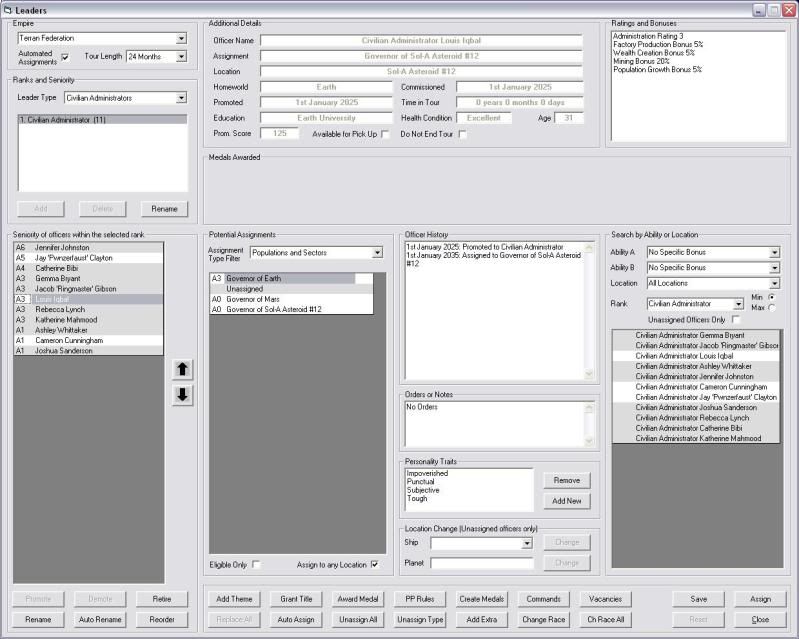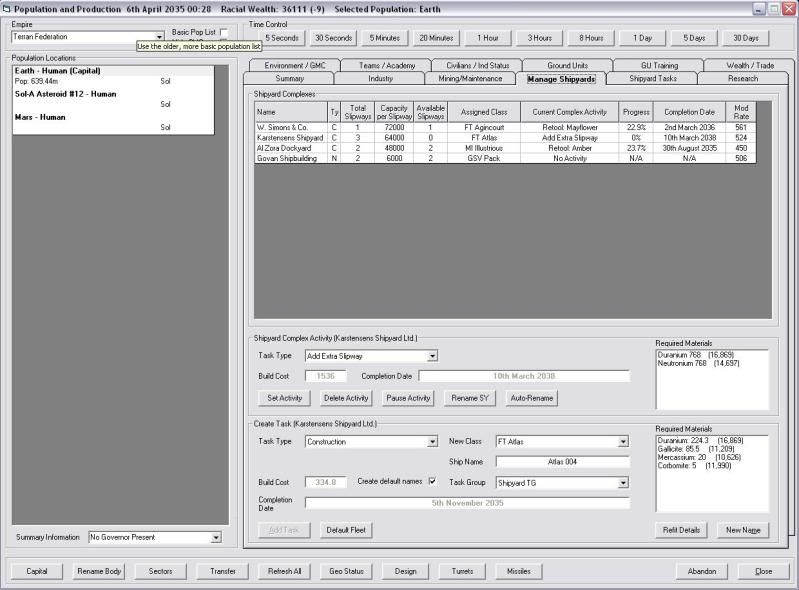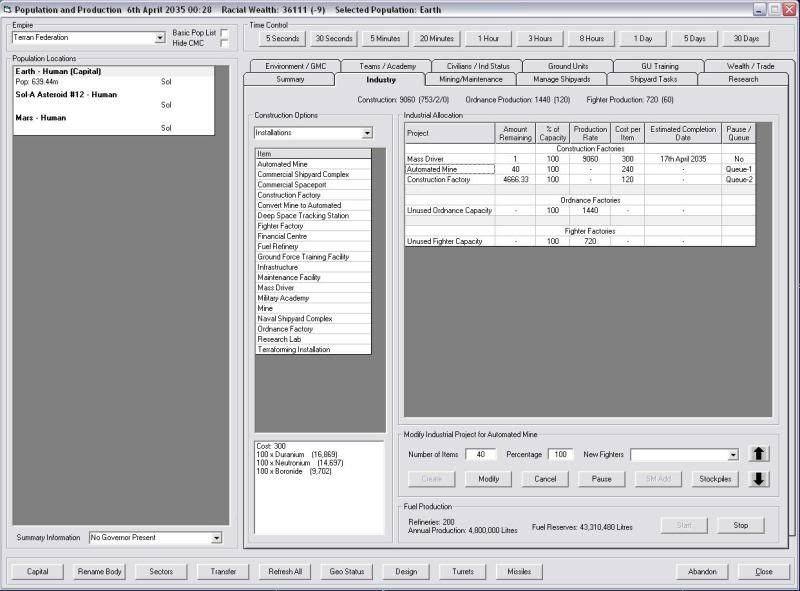First entry: 1st January, 2035:My first day in office. Certainly feels strange, being governor of Earth. Surreal-ish feeling. Pretty great. Relieved Governor Gibson this morning, and though he seemed a bit disappointed to be leaving his post, he also seemed to have felt a great weight taken from his shoulders. I wonder if I'll feel the same way in 2045.
Initial Statistics:Human Population: 645.67 million (all on Earth)
Infrastructure:
3 Commercial shipyards:
- W. Simons & Co.: 1 Slipway, 72000 ton capacity per slipway, tooled for Agincourt class Freighter.
- Karstensens Shipyard Ltd.: 3 Slipways, 64000 ton capacity per slipway, tooled for Ark Royal class Luxury Liner.
- Al Zora Dockyard: 2 Slipways, 48000 ton capacity per slipway, tooled for Illustrious class Miner.
1 Military shipyard:
- Govan Shipbuilding Co.: 2 Slipways, 6000 ton capacity per slipway, tooled for Pack class Gravitational Survey Vessel.
Level 1 Military Academy
Level 4 Deep Space Tracking Station
65 Maintenance Facilities (3.25 million employees; 13,000 ton ship capacity)
1 Mass Driver (5,000 tn/yr capacity)
733 Construction Factories (36.65 million employees; 8820 construction capacity)
120 Ordnance Factories (6 million employees; 1440 ordnance construction capacity)
60 Fighter Factories (3 million employees; 720 fighter construction capacity)
200 Fuel Refineries (10 million employees; 4,800,000 liters of fuel produced annually)
320 Mines (16 million employees)
160 Automated Mines
20 Research Labs (20m employees)
4 Ground Force Training Facilities
Government-owned Ships:
Commercial:
[/list][/list]Agincourt class Freighter 13350 tons 103 Crew 211.4 BP TCS 267 TH 300 EM 0
1123 km/s Armour 1-50 Shields 0-0 Sensors 1/1/0/0 Damage Control Rating 1 PPV 0
Maint Capacity 10 MSP Max Repair 38 MSP
Cargo 10000 Cargo Handling Multiplier 10
Ion Engine E0.8 (2) Power 150 Fuel Use 8% Signature 150 Armour 0 Exp 1%
Fuel Capacity 50,000 Litres Range 84.2 billion km (868 days at full power)
This design is classed as a commercial vessel for maintenance purposes
Ark Royal class Luxury Liner 13200 tons 428 Crew 561.8 BP TCS 264 TH 600 EM 0
2272 km/s Armour 1-49 Shields 0-0 Sensors 1/1/0/0 Damage Control Rating 1 PPV 0
Maint Capacity 27 MSP Max Repair 38 MSP
Passengers 750
Ion Engine E0.8 (4) Power 150 Fuel Use 8% Signature 150 Armour 0 Exp 1%
Fuel Capacity 50,000 Litres Range 85.2 billion km (434 days at full power)
This design is classed as a commercial vessel for maintenance purposes
Illustrious class Miner 27150 tons 548 Crew 763.4 BP TCS 543 TH 150 EM 0
276 km/s Armour 1-80 Shields 0-0 Sensors 1/1/0/0 Damage Control Rating 1 PPV 0
Maint Capacity 18 MSP Max Repair 120 MSP
Asteroid Miner: 5 module(s) producing 50 tons per mineral per annum
Ion Engine E0.8 (1) Power 150 Fuel Use 8% Signature 150 Armour 0 Exp 1%
Fuel Capacity 50,000 Litres Range 41.4 billion km (1736 days at full power)
This design is classed as a commercial vessel for maintenance purposes
Resolution class Geological Survey Vessel 4200 tons 208 Crew 654.4 BP TCS 84 TH 300 EM 0
3571 km/s Armour 1-23 Shields 0-0 Sensors 1/1/0/5 Damage Control Rating 2 PPV 0
Maint Capacity 195 MSP Max Repair 100 MSP
Ion Engine E0.8 (2) Power 150 Fuel Use 8% Signature 150 Armour 0 Exp 1%
Fuel Capacity 50,000 Litres Range 267.8 billion km (868 days at full power)
Geological Survey Sensors (5) 5 Survey Points Per Hour
This design is classed as a commercial vessel for maintenance purposes
:
Pack class Gravitational Survey Vessel 3150 tons 98 Crew 240.2 BP TCS 63 TH 300 EM 0
4761 km/s Armour 1-19 Shields 0-0 Sensors 1/1/1/0 Damage Control Rating 1 PPV 0
Annual Failure Rate: 79% IFR: 1.1% Maint Capacity 48 MSP Max Repair 100 MSP Est Time: 0.6 Years
Ion Engine E0.8 (2) Power 150 Fuel Use 8% Signature 150 Armour 0 Exp 1%
Fuel Capacity 50,000 Litres Range 357.1 billion km (868 days at full power)
Gravitational Survey Sensors (1) 1 Survey Points Per Hour
This design is classed as a military vessel for maintenance purposes
Tribal class Geological Survey Vessel 1350 tons 133 Crew 325.8 BP TCS 27 TH 120 EM 0
4444 km/s Armour 1-10 Shields 0-0 Sensors 1/1/0/2 Damage Control Rating 2 PPV 0
Annual Failure Rate: 7% IFR: 0.1% Maint Capacity 302 MSP Max Repair 100 MSP Est Time: 8.6 Years
Ion Engine E8 (2) Power 60 Fuel Use 80% Signature 60 Armour 0 Exp 5%
Fuel Capacity 50,000 Litres Range 83.3 billion km (217 days at full power)
Geological Survey Sensors (2) 2 Survey Points Per Hour
This design is classed as a military vessel for maintenance purposes

First order of business was to go over the administrative staff, and look into any changes that could be made. Jennifer Johnston, a talented administrator, was assigned to the governorship of the Asteroid 12 mining colony by my predecessor. A worthy choice, however after poring through the files on the other administrators available, I made the decision to replace her with Louis Iqbal. Iqbal, though he lacks the administrative talent of Ms. Johnston, has far more experience and expertise regarding mining operations.
Upon review of the current ship designs, I found the Agincourt class freighter to be woefully inadequate in the long term. With a mere 10,000 cubic meter carrying capacity, it would not even be able to carry a single automated mine to a colony. As such, I ordered the design of a new class, christened the Atlas:
Atlas class Freighter 30000 tons 149 Crew 334.8 BP TCS 600 TH 450 EM 0
750 km/s Armour 1-86 Shields 0-0 Sensors 1/1/0/0 Damage Control Rating 1 PPV 0
Maint Capacity 7 MSP Max Repair 38 MSP
Cargo 25000 Cargo Handling Multiplier 10
Ion Engine E0.8 (3) Power 150 Fuel Use 8% Signature 150 Armour 0 Exp 1%
Fuel Capacity 150,000 Litres Range 112.5 billion km (1736 days at full power)
This design is classed as a commercial vessel for maintenance purposesWith two and a half times the cargo space as the Agincourt, the Atlas could carry one of almost any facility currently in use. The increased size came at the expense of speed, but the increased carrying capacity and greater range make it worth it.
Next, in anticipation of future Martian colonization efforts, I commissioned the design of a new colony ship. The new design, christened the Mayflower, was produced within weeks.
Mayflower class Colony Ship 20000 tons 236 Crew 880.4 BP TCS 400 TH 750 EM 0
1875 km/s Armour 1-65 Shields 0-0 Sensors 1/1/0/0 Damage Control Rating 1 PPV 0
Maint Capacity 28 MSP Max Repair 38 MSP
Colonists 50000 Cargo Handling Multiplier 10
Ion Engine E0.8 (5) Power 150 Fuel Use 8% Signature 150 Armour 0 Exp 1%
Fuel Capacity 350,000 Litres Range 393.8 billion km (2430 days at full power)
This design is classed as a commercial vessel for maintenance purposes
The design of the Mayflower was based upon that of the Atlas. The five cargo holds aboard the Atlas were replaced by five cryogenic transport modules, each capable of transporting 10,000 hibernating colonists, for a total capacity of 50,000. Additionally, two more engines were added, along with capacity for an extra 200,000 liters of fuel. Its high speed would make it ideal for transport between Earth and any future colonies.
As a last modification to our ship line-up, I ordered a modification to the Illustrious class miner. By adding a pair of additional engines, plus 200,000 more litres of fuel, it was possible to nearly triple the speed, as well as increasing the range by more than 4 times. The new ship was named the Amber.
Amber class Miner 30000 tons 620 Crew 914.8 BP TCS 600 TH 450 EM 0
750 km/s Armour 1-86 Shields 0-0 Sensors 1/1/0/0 Damage Control Rating 1 PPV 0
Maint Capacity 19 MSP Max Repair 120 MSP
Asteroid Miner: 5 module(s) producing 50 tons per mineral per annum
Ion Engine E0.8 (3) Power 150 Fuel Use 8% Signature 150 Armour 0 Exp 1%
Fuel Capacity 250,000 Litres Range 187.5 billion km (2893 days at full power)
This design is classed as a commercial vessel for maintenance purposesI ordered the W. Simons & Co. shipyard facility to retool for the construction of Mayflower class vessels, while the Karstensens Shipyard retooled for the Atlas, and the Al Zora Dockyard began switching production to the upgraded mining ship. Retooling for the construction of the Atlas would take just over 4 months, while retooling for the Mayflower would take more than a year. Retooling for the Amber would complete between the former two.
Finally, I looked over a proposal from the Chiefs of Staff of the Terran Federation Armed Forces to create a unified designation system for missile ordnance and electronic systems, to simplify and unify identification of these systems.
Terran Federation Vehicle Designation System (VDS)Vehicle in this context refers to a any unmanned missile, drone, buoy or mine in use by the Federated Nations. The VDS allows easy identification of the type and purpose of each vehicle. The required format is as follows:
(Primary Launch Platform)(Mission)(Vehicle Type) - (Design Number)(Series Letter)(Popular Name)
Primary Launch PlatformA - Spacecraft powered by fighter engine
B - Multiple Launch Environments
C - Captor Mine
G - Planetary Defence Centre
L - Box Launcher
R - Spacecraft
U - Stealthy Spacecraft
MissionD - Decoy
E - Special Electronics
G - Spacecraft Attack
I - Interception (of missiles or perhaps fighters)
L - Detection or Reconnaissance
M - Scientific Instruments (e.g. geosurvey buoy)
Vehicle TypeB - Booster or First Stage
C - Captor Mine
M - Guided Missile
N - Probe or Recon Drone
R - Submunition
S - Unarmed Satellite or Buoy
Design NumberEach vehicle type will have a design number based on chronological order of design. It is possible there could be multiple versions of the same vehicle type intended for different purposes or with different launch options. These versions would use the same design number with different letter combinations. For example, the RGM-1A might be a spacecraft-launched spacecraft-attack missile while RLN-1A is a spacecraft-launched reconnaissance drone, which replaces the warhead of the RGM-1 with a sensor package but is otherwise identical.
Series LetterVariants of a basic vehicle type are designated by a suffix letter. The first model always receives suffix "A" and subsequent series letters are assigned in strict sequence (omitting "I" and "O" to avoid confusion with numerals "1" and "0"). The series letter is a mandatory component of the VDS and therefore 'plain' designations such as 'RIM-12' always designate the general type of vehicle and never a specific model.
Popular NameMost vehicles receive a 'popular name' or acronym early in the planning or development phase. While the name is not part of the official designation, many missiles and other vehicle types are almost exclusively referenced by their name, both in the popular press and in official government news releases and documents.
Examples
RGM-1A Falchion is a Spacecraft-launched (R) Guided-missile (M) intended to attack other Spacecraft (G)
RLN-2A Raven is a Spacecraft-launched (R) Recon Drone (N) used for reconnaissance (L)Electronics Designation System (EDS)The older US Joint Electronics Type Designation System provided a basis for the Terran Federation's naming scheme for its electronic systems, known as the Electronics Designation System. All designations are proceeded by TF/ for Terran Federation.
PlatformA - Spacecraft powered by fighter engine
B - Stealthy Spacecraft
F - Planetary Defence Centre
G - Spacecraft powered by gunboat engine
S - Spacecraft powered by military or commercial engines
Equipment TypeA - Invisible Light
D - Radioactivity Detection
G - Gravitational Survey
L - Countermeasures
M - Geological Survey
P - Active Sensor
Q - Thermal Detection
PurposeD - Missile Detection
G - Fire Control
N - Navigation
Q - Special or Combination
R - Receiving or Passive Detection
S - Active Search
Y - Surveillance (used for particularly large active sensors)
Examples:
The TF/SPS-7 Active Search Sensor is a Spacecraft-mounted (S) Active Sensor (P) used for Area Search (S)
The TF/SQR-1 Thermal Sensor is a Spacecraft-mounted (S) Thermal Detection sensor (Q) used for Passive Detection (R)(all credit goes to Steve Walmsley, head developer of Aurora, for devising this system. From here:
http://aurora.pentarch.org/viewtopic.php?f=93&t=1709)
Impressed, I approved of the system immediately. It was put to immediate use as I put in a request for a new active sensor system, meant to become integral to future survey vessels, along with a line of passive thermal and electromagnetic emission detectors.
21st February 2035The previous military tour period has come to an end, and the officers were shifted around. Three were deemed surplus and retired, hopefully opening up their positions for new talent.
In other news, the geological survey of the asteroid belt is proceeding swimmingly. One asteroid in particular, number 135, has proven to have an abundance of several resources.
Duranium: 123,495 tons, Accessibility 1
Neutronium: 4,259, 0.9
Corbomite: 101, 1
Tritanium: 25,005, 0.9
Mercassium: 3,629, 0.9
Vendarite: 23,443, 0.9
Gallicite: 19,058, 0.9
The presence of so many high value resources came as a blessing to our resource-strapped economy. Plans are being drawn up to transport some automated mines there, once the new Atlas class freighters are constructed. The Duranium in particular is of interest, considering the enormous quantity and high accessibility of it, and its ubiquity in ship construction. This asteroid could fuel ship construction for years to come.
Also, the Federation's income fell into the negatives over the past month. The culprit was the retooling of the shipyards begun in January. It's only a loss of two credits every five days, but it warrants attention.
1st March 2035Colonel George Griffin, commander of the 1st Heavy Assault Battlion, was killed in a training accident today. He was a skillful commander and will be sorely missed. His replacement, Colonel Eleanor Young, is nowhere near as skilled as he is. But any commander is better than none at all, I suppose.
6th April 2035
Karstensens Shipyard Ltd. sent word today that they've successfully retooled for construction of Atlas class freighters. I immediately authorize production of three new ships, filling all their slipways. They are scheduled for delivery in early November. Included in Karstensens' message was an announcement that they had begun construction on a fourth slipway, due to be finished in roughly three years.

In anticipation of the freighters' addition to the fleet, I order the production of construction factories to cease, and order a new mass driver and 40 new automated mines.
16 June 2035Ashley Ferguson's research team announced the development of a next-generation propulsion system. Called the magneto-plasma drive, it is essentially an amped-up ion drive. More powerful control computers and electromagnets allow large amounts of more massive ionized plasma particles to be shunted backwards, generating greater amounts of thrust than the present-generation ion engines can boast. New designs for military and commercial vessels are immediately ordered. They'll be incorporated into new and updated designs at the first opportunity.
11 December 2035With the finalization of the new long-range active sensor system and magneto-plasma drives, the final touches are put on a new survey vessel long in development. Designated the Leif Ericson class Science Vessel, it is more than twice the size of previous survey vessels, and boasts a suite of geological, gravitational, and active sensors superior to any ship in the fleet.
Leif Ericson class Science Vessel 3000 tons 278 Crew 978.6 BP TCS 60 TH 320 EM 0
5333 km/s Armour 1-18 Shields 0-0 Sensors 1/1/4/4 Damage Control Rating 2 PPV 0
Annual Failure Rate: 36% IFR: 0.5% Maint Capacity 408 MSP Max Repair 150 MSP Est Time: 3.39 Years
Rolls Royce Magneto-plasma Drive E8 (4) Power 80 Fuel Use 80% Signature 80 Armour 0 Exp 5%
Fuel Capacity 300,000 Litres Range 225.0 billion km (488 days at full power)
TF/SPY-1 Surveillance Sensor (1) GPS 8000 Range 48.0m km Resolution 100
Improved Gravitational Sensors (2) 4 Survey Points Per Hour
Improved Geological Sensors (2) 4 Survey Points Per Hour
This design is classed as a military vessel for maintenance purposes
Govan Shipbuilding Co. is immediately commissioned to retool for production of the new ship. They give a time frame of roughly a year for the retooling process. When completed, two ships will be built, with a further two possible as circumstances dictate.

 Author
Topic: Succession Game: Aurora (V.5.14.0) (Read 2124 times)
Author
Topic: Succession Game: Aurora (V.5.14.0) (Read 2124 times)
